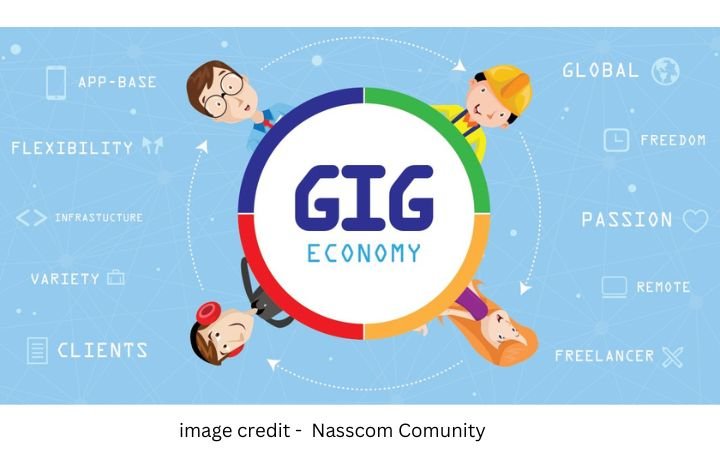The Gig Economy: Redefining Work and Services
The gig economy is a part of the modern economic landscape that has changed how services are delivered and how work is structured. If you have ever called a freelance taxi driver using an app, booked a holiday rental, ordered food, or purchased a handmade craft, then you have actively participated in this dynamic segment of the economy.
Defining the Gig Economy
The gig economy refers to an arrangement where people exchange labor for money in short-term or payment-by-task periods, often using digital platforms that actively match the service providers with customers. In the UK, the government defined it as a sector with exchanges of that kind, opening the debate about the benefits and challenges of such a sector.
In one perspective, the gig economy has been considered one of the positive contributors to productivity and employment. On the other hand, it raises debates on consumer and worker protection and labor-market policies.
Worker Rights and Legal Precedents
The status and rights of workers are among the most important concerns in the gig economy. Gig workers often waive the rights that traditional employees enjoy, such as paid leave, minimum wage guarantees, and pensions.
However, there have been significant legal developments addressing this issue. For example, in February 2021, a UK court ruled that drivers for a popular ride-hailing app were entitled to benefits like paid holidays, a minimum wage, and pension contributions. This landmark decision set a precedent, influencing similar cases worldwide and prompting policymakers to rethink regulations in the gig economy.
It makes policymakers’ lives very challenging since as the gig economy companies grow to be more powerful, innovation will need to go hand in hand with fairness, where workers would have adequate protection under the auspices of growing economic activities. It is complicated to this day as product-market regulations, competition policies, tax laws, and labor-market rules continue to evolve as a new paradigm in the economic sense.
Advantages and Disadvantages to Gig Workers
Most often, people describe gig work as having the greatest appeal because of independence and flexibility. The UK government’s survey shows that most gig workers are satisfied with the autonomy and adaptability that their jobs allow them to have. For students who want to earn money while studying or for primary caregivers who need to balance school or daycare schedules, platforms in the gig economy offer the ultimate flexibility.
However, the same survey found high discontent in and around income levels and job-related benefits. In fact, one in four respondents claimed to be very or fairly dissatisfied with this aspect of the work. Irregular income and lack of benefits such as health insurance or retirement savings plans leave many gig workers more financially vulnerable compared to others.
Categorization of Gig Workers
A 2016 study by McKinsey categorized independent workers into four categories:
- Free Agents: These individuals make gig work their primary source of income.
- Casual Earners: They prefer to do gig work as it supplements their income.
- Reluctants: These are the workers who mainly rely on gig work but would prefer traditional employment if possible.
- Financially Strapped: These are individuals who need gig work to carry out their daily operations.
Each category presents different challenges and opportunities that policymakers need to adjust the regulations to accommodate the various needs of gig workers. According to the McKinsey Global Institute, benefits, income security measures, training, and credentialing offer a huge opportunity for innovation and improvement in the gig economy.
Generational Patterns in the Gig Economy
Further generational differences occur in participation. A 2023 survey on US freelancers showed that among the respondents, 45% came from Millennials, compared to 15% from Gen Z and as low as only 9% from Baby Boomers.
Patterns show how these generations are now changing the concept of work due to the current preference for remote work and increasingly digital platforms, especially among the more youthful workforce.
The financial issues that gig workers face are quite different, mainly in the areas of income management, expenses, and tax obligations. For gig workers, keeping track and reporting their earnings is a laborious process as compared to employees.
In the United States, for instance, gig workers pay self-employment taxes, which comprise both the employer and employee parts of Social Security and Medicare contributions, totaling 15.3% of net income.
To balance out these expenses, gig workers can claim deductions for car maintenance, gas, insurance, and home office setups. Budgeting is key to handling the ups and downs of income and saving for taxes and personal spending. According to financial experts, 20-25% of the profit should be allocated to federal taxes, and 5% to state taxes to avoid liability surprises.
The Employer Perspective
The rise of the gig economy has dramatically impacted how employers manage their workforce. In a competitive talent market, companies are increasingly relying on freelancers, gig workers, and independent contractors to build a flexible and agile labor force.
This approach allows businesses to quickly adjust workforce size and expertise to meet changing demands, reducing recruitment and training costs.
Employers also get on-demand access to specialized skills, but it comes without long-term commitment to a full-time job. Flexibility is challenging; it challenges the team’s cohesiveness and how to motivate a workforce that may not be invested in the company’s goals for the long term. The legal consideration also makes it even more complex; companies must walk the line in the worker classification to avoid the misclassification problem.
Policy Implications and the Future of Work
The rise of the gig economy presents enormous challenges and opportunities for public policymakers. Ensuring all categories of gig workers remain satisfied requires some level of policy adaptation to respond to diverse needs. Benefits, income security, training, and credentialing must be reimagined for the digital age.
Policymakers must balance fostering innovation with the need to ensure fair treatment of workers. That includes solutions in income stability, improving access to benefits, and opportunities for upskilling. As digital technologies continue to remake the world of work, independent workers and employees will have to be proactive about managing their careers.
Conclusion
The gig economy represents a fundamental shift in how work is structured and delivered. The gig economy offers tremendous benefits, such as flexibility and efficiency, but it also imposes difficult hurdles that require careful regulation and innovation by policymakers, employers, and workers to ensure its proper evolution for the benefit of all stakeholders.
If issues like workers’ rights, financial stability, and benefits access are improved, the gig economy can be made to continue thriving and really promote fairness and inclusiveness in the labor market.










